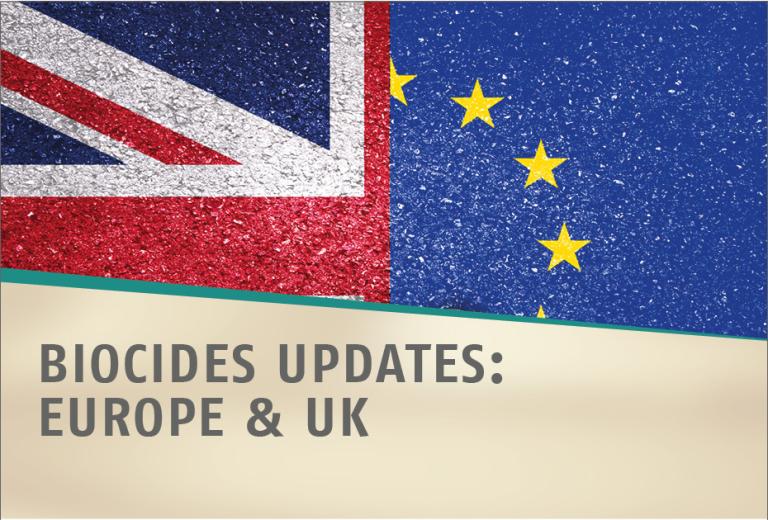Biocides Updates from Europe and UK
EUROPE
Highlights from ECHA
New Technical Agreement for Biocides (TAB) on APCP
On April 17th, a new TAB on APCP was published.
The news is:
- Some editorial amendments in section 7.3 on the use of DSC for waiving explosive properties and self-reactive substances
Change of 3.1.3 Number of reference sources
The CAR can include as many (reference) sources as complying with the reference specification. However, these sources must be included in the CAR for approval of the active substance. All sources, which are not included in the CAR but used for biocidal products, must apply for the assessment of technical equivalence to ECHA before they can be used for product authorisation. In case of several sources for one active substance dossier (e.g. a task force), one specification which captures all sources should be set. This is done by considering the specification for each source independently and combining the "worst case" concentrations of the active substance and the impurities to achieve the specification, i.e. lowest content of active substance and highest content of impurities. Note that all impurities should be stated in the specification, even if only present in one source. This specification is the basis to set the reference specification.
New CLP hazard classes will be included in IUCLID
Starting from April 29th the IUCLID software will incorporate the latest hazard classifications for substances and mixtures. These classifications encompass categories such as endocrine disruptors (ED) affecting human health or the environment, as well as substances identified as persistent, bioaccumulative, and toxic (PBT), very persistent and very bioaccumulative (vPvB), and persistent, mobile, and toxic (PMT), including very persistent and very mobile (vPvM) substances.
Upon integration, companies can include relevant hazard information when submitting dossiers under the CLP, REACH, and Biocidal Products regulations to ECHA. Additionally, ECHA is revising the manuals on dossier preparation to offer guidance on the updated IUCLID fields.
Furthermore, ECHA plans to augment its recently introduced chemicals database, ECHA CHEM, in autumn 2024. This expansion will encompass a revamped classification and labelling inventory, accommodating the newly added hazard classes. Guidance materials regarding these hazard classes will be made accessible later in the year.
Updates on working procedures
At the end of March a number of working procedures were updated by ECHA, namely:
Working procedure for active substance approval and renewal (applicable from 05/03/ 2024)
Working procedure for Union authorisation application (22/03/2024)
Working Procedure for major changes application of a Union authorisation (22/03/2024)
Working procedure for minor changes application of a Union authorisation (22/03/2024)
Linguistic check of SPC translations for same biocidal products of Union authorisation (22/03/2024)
Highlights from Competent Authorities (CA)
CA-March24-Doc.7.4 Applicability of ECHA/EFSA guidance on the impact of water treatment
The competent authorities discussed at the CA meeting (14-15 March 2024), the applicability of the ECHA Guidance on the impact of water treatment processes on residues of active substances or their metabolites in water abstracted to produce drinking water.
The outcome of the meeting was that no agreement on the applicability of the guidance could be made. The current ECHA proposition is that the guidance:
- would not be applicable to active substances dossiers in the review programme, in line with the agreement reached in the document CA-Dec23-Doc.5.4 - Final - Extension of RP beyond 2024.docx;
- would be applicable to future applications outside of the review programme or at the renewal of the approval (excluding ongoing renewal evaluations). For active substances, the applicability of the guidance would start two years after the publication date. For biocidal product authorizations the guidance would be applied, only once it has been used in the evaluation of the active substance(s) the product contains.
This topic will be discussed again the next CA meeting on 19-21 June 2024.
News from ISO
ISO 7581:2023 Evaluation of bactericidal activity of a non-porous antimicrobial surface used in a dry environment
We shortly discussed the topic in the March newsletter. If you wish to have a deeper understanding of this Standard, please follow this link.
Common practices
Substances of concern (SoCs)
SoCs can give rise to doubts and questions. We would like to share with you our feedback from the authorities. In particular we address two issues:
BIOCIDAL PRODUCTS
Q: Does an analytical method for an SoC need to be provided as part of a product authorisation even if the concentration of the SoC does not increase during storage and therefore this SoC does not need to be addressed in the storage study?
A: In principle, according to Annex III, point 5.1 of Regulation (EU) No 528/2012
(Biocidal Products Regulation) for a substance that has been identified as a SoC in a biocidal product, a validated analytical method must be submitted.
However, this is not necessary if it is demonstrated that an increase in the content of the respective substance in the biocidal product during storage can be ruled out (see APCP-TAB1, section 6.2.1.2). This is possible for many substances of concern.
If the content of the substance of concern increases during storage (e.g. because it is a degradation product), the submission of a validated analytical method and quantification of the substance of concern as part of the storage stability is necessary.
ACTIVE SUBSTANCES
Q: At the time of active substance approval, do analytical methods for SoCs have to be included in the dossier?
A: Analytical methods for SoCs do not have to be submitted at the time of active substance approval but are only evaluated during product authorisation.
Only data that support safe use must be submitted for the representative product.
UK
Non approval decisions on active substances
The UK’s Health and Safety Executive publishes a decision to remove 63 Active Substances/Product Type combinations from the GB market.
The List of the non-approval decisions was updated in March and can be found here.


